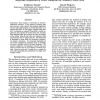HCI
2007
14 years 8 months ago
2007
Abstract. We describe the results of an empirical study comparing an interactive Information Visualization (InfoVis) technique called Gravi++ (GRAVI), Exploratory Data Analysis (ED...
SDM
2010
SIAM
14 years 8 months ago
2010
SIAM
Many sorts of structured data are commonly stored in a multi-relational format of interrelated tables. Under this relational model, exploratory data analysis can be done by using ...
KDD
1997
ACM
14 years 11 months ago
1997
ACM
Exploratory data analysis is inherently an iterative, interactive endeavor. In the context of massive data sets, however, many current data analysis algorithms will not scale appr...
IUI
1997
ACM
14 years 11 months ago
1997
ACM
Exploratory data analysis (EDA) plays an increasingly important role in statistical analysis. EDA is di cult, however, even with the help of modern statistical software. We have d...
ICML
2000
IEEE
14 years 11 months ago
2000
IEEE
We present feature transformations useful for exploratory data analysis or for pattern recognition. Transformations are learned from example data sets by maximizing the mutual inf...
GECCO
2004
Springer
15 years 23 days ago
2004
Springer
We illustrate with two simple examples how Interactive Evolutionary Computation (IEC) can be applied to Exploratory Data Analysis (EDA). IEC is particularly valuable in an EDA cont...
MDAI
2007
Springer
15 years 1 months ago
2007
Springer
Formal concept analysis (FCA) is a method of exploratory data analysis. The data is in the form of a table describing relationship between objects (rows) and attributes (columns), ...
IV
2007
IEEE
15 years 1 months ago
2007
IEEE
High-dimensional data is, by its nature, difficult to visualise. Many current techniques involve reducing the dimensionality of the data, which results in a loss of information. ...
IV
2007
IEEE
15 years 1 months ago
2007
IEEE
The evaluation of Information Visualization (InfoVis) techniques can help to identify specific strengths and weaknesses of these methods. The following article describes the resu...
ALT
2001
Springer
15 years 4 months ago
2001
Springer
The growing use of information visualization tools and data mining algorithms stems from two separate lines of research. Information visualization researchers believe in the impor...

